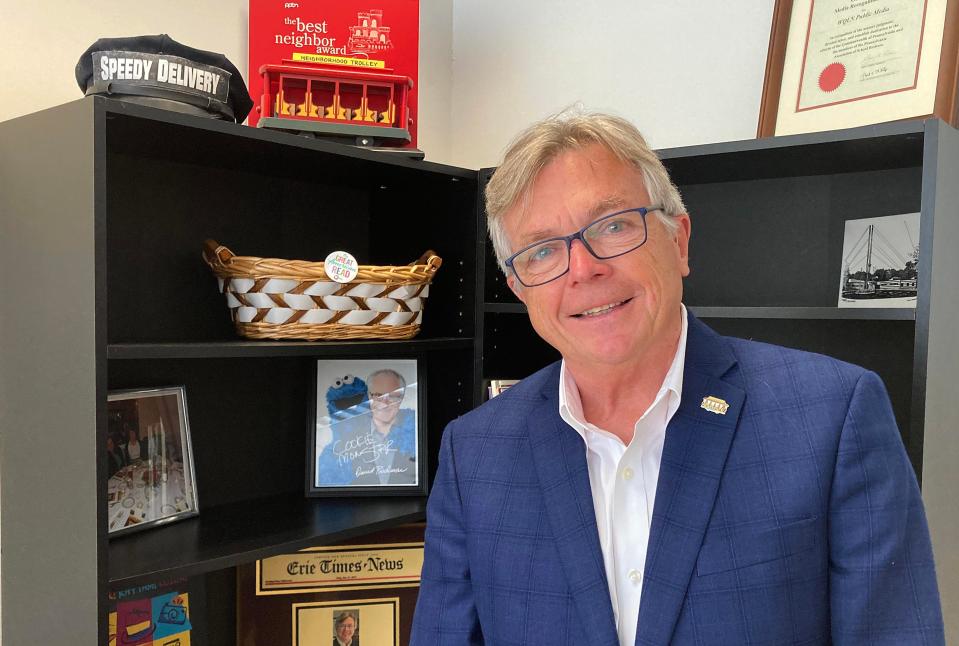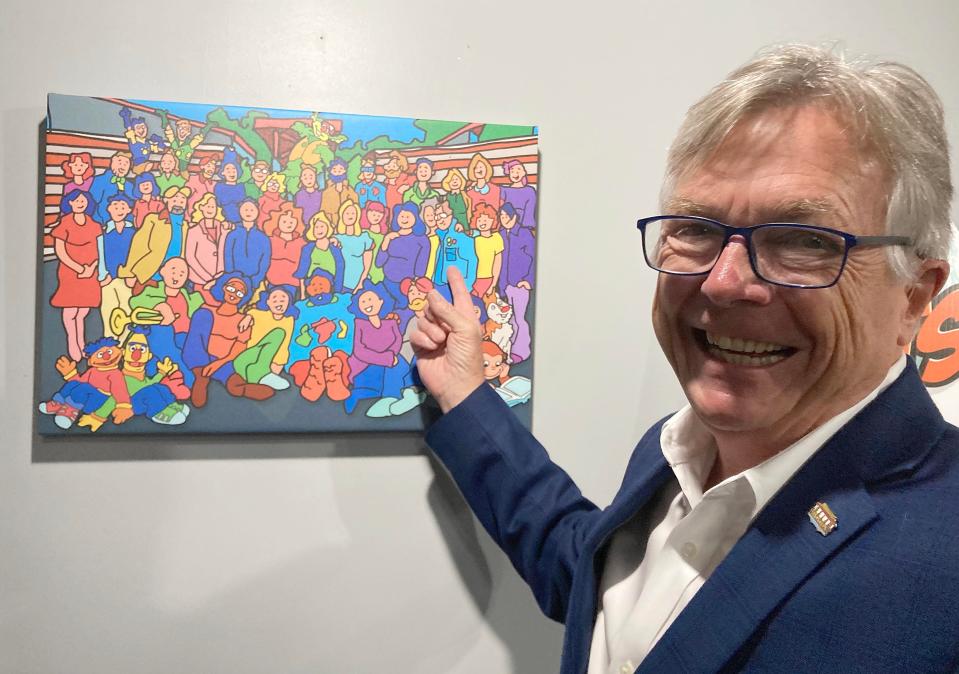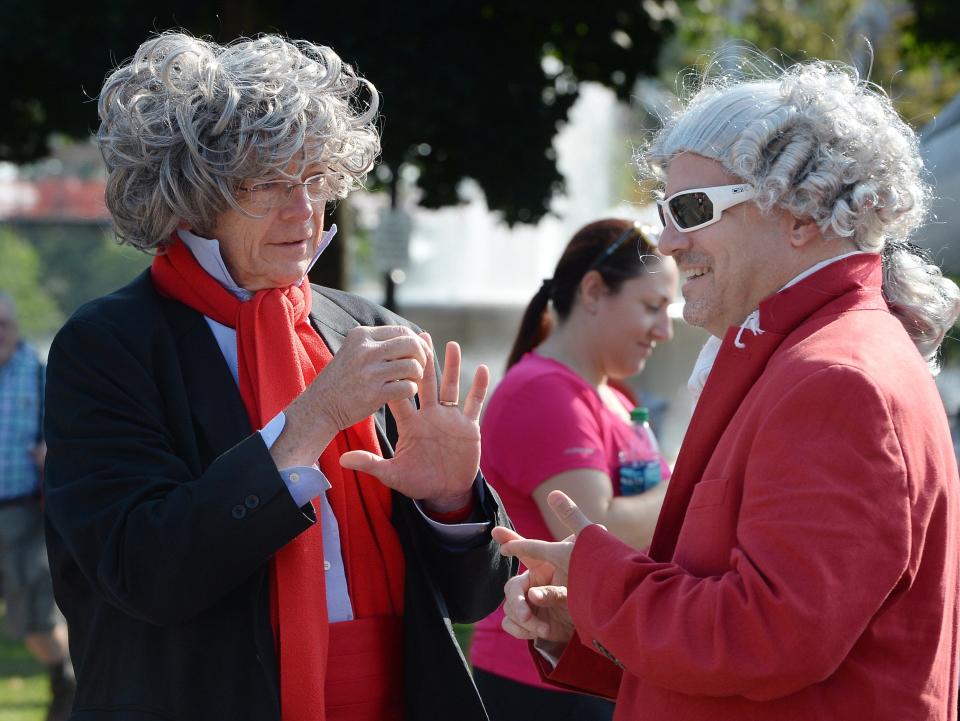Tom New's long career at Erie's WQLN coming to an end with retirement
Tom New was returning to Erie from a "Downton Abbey" tea in London, Ontario, Canada, when migraines forced him straight to the hospital.
New, the president and CEO of WQLN public TV and radio, was waiting in a room when an aide asked if there was anything he could do.
"Can we switch the (TV) channel?" New asked and the aide changed it to New's preferred WQLN, which was showing a "Nature" episode about goats that live on the side of a mountain in Argentina. The aide started watching with New.
"He moves my feet aside and sat down on the bed. And he was saying, 'I've never seen this before.' Because these goats are running up this vertical cliff and jumping cliff to cliff," New said.
It was just one of the moments in New's nearly 25-year career at WQLN that exemplified what Erie's PBS and NPR affiliates do for and mean to the community. New, 67, started at WQLN in December 1998 and spent the last decade of that career as president and CEO, a job he'll retire from on Sept. 15.

Dressed in a white shirt under a blue sport coat with a "neighborhood trolley" pin from the PBS shows "Mister Rogers' Neighborhood" and "Daniel Tiger's Neighborhood" on the lapel, New sat down with the Erie Times-News/GoErie.com to talk about his time at WQLN and his retirement. He sported a bit of whimsy between his khakis and brown loafers where his orange, blue and white striped socks bore the words "Whipper Snapper." The interview with New has been edited for length and clarity.
The journey to WQLN
Question: When you started in 1998, what shows were on the air?
Answer: "Downton Abbey" wasn't on the air. But many of our signature programs were on the air back then. PBS, sometime in the 1990s, they identified Sunday as British drama, Monday as collectibles and independent films, Tuesday as biography, Wednesday as science, Friday was performance. So a lot of the shows that are still on were big shows then. "Masterpiece" was called "Masterpiece Theater." Wednesday night was still "NOVA" and "Nature." And "Antiques Roadshow" was the ratings champ on Monday nights at 8 o'clock. And it has remained the ratings champ. Julia Child was still alive and she had one of her programs.
Why was this someplace you wanted to work?
I was 43 and I was working over at WJET as one of the senior managers at the station. ... I loved that job. The station was sold to a company, Nexstar, so my employee number just went up into the thousands. I got the feeling, working for a big corporation where I would never have any conversations with the powers that be, it was almost better for me to start all over again. So I came to WQLN as a graphic artist and it was an entry-level position. That's unusual, somebody does that in mid-life.
But at WQLN ... there was just something that felt more Erie, Pennsylvania, more local about working at WQLN, for me, than for any of the corporate-owned media.

What prepared you for that first job at WQLN? What is your educational background?
I had a degree from the Art Institute of Pittsburgh that I got in 1978. By the late '90s, I was well versed in a lot of different forms, everything from hand lettering, I was pretty much an illustrator, that was probably my skill set then, so it was easy to come from one form of computer artwork (to) here.
In the early '80s, I became a marketing manager at WJET and then turned that into marketing and public relations that became creative services. That's what I brought over to WQLN and it's why I was able to make the jump from a graphic artist to marketing, creative services and taking that skill set of doing events in the community that made a lot more sense doing them for a public TV station than doing them for a commercial entity.
What was the journey like from graphic artist to president and CEO?
If there ever was a pathway to success for me, it was because I lived in a town the size of Erie and I worked at a company the size of WQLN. And I always had this willingness to work hard on any project and so the graphic art job turned into a marketing/community services job but there was a lot of PR there.
One of the things WQLN was going through at the time is we had a legacy of producing documentaries and we were no longer doing that. But we're a local public television station. I took it upon myself to turn that into creating community events here in Erie. So if we couldn't afford to do the big documentaries, we could certainly do a presentation of the "1812 Overture" on the bayfront. Or we could do any number of things that we've done with our Kids Club groups. We produced a series of concerts in Crawford County called Crawford County Music Fest. So it was a number of those kind of entertainment well bred with WQLN that kind of carried us over those early years, those 2000s, until we were able to start making programming again.
From 2017: WQLN celebrates 50 years on the air
Importance of public TV, radio
Is there one accomplishment that you're most proud of?
There really were so many it's really hard to figure out what that is because certainly when we did the "1812 Overture" on the bayfront and you're sitting there and you've got cannon fire going off and fireworks and you've got the Philharmonic performing the "1812 Overture," you just sit there and think, "How did this come about? This is just so fabulous." That's a big moment, but at the same time getting the people to a very rainy very muddy performance of The Rev. Peyton's Big Damn Band ... where there's 400 people watching this, it's the same kind of feeling. ...
Or another moment when you'll bring Daniel Tiger or Curious George or Cat in the Hat and a little kid sees those characters and they just light up like it's Christmas morning.
What's been the best part of the job?
It's the opportunity that I've had to mingle with the people inside of the (WQLN) building but also to talk to people, be with people in Erie, in the community, all kinds of different people. ... I think that I've enjoyed having conversations with those folks, Erie people, more than just about anything. ... It's everything, it's shopping in Wegmans where somebody comes up and they say, "You're way too liberal up there," or somebody says, "You're way too conservative." ... But also very sweet things where people talk about the movies on Saturday night or the kids programming.
What's been the hardest part of the job?
The staff here at WQLN is very very close and sometimes you have to make decisions that not everybody agrees with. ... That's always tough because I've always been somebody that wants consensus. ...
Financial situations, that has always been a constant with WQLN. I know back in '15 and '16, it was something that haunted my dreams on a nightly basis. When you have to make a payroll every two weeks and you're not sure where the money is going to come from, it's hard. ...
We get one-third of our funding from the Corporation for Public Broadcasting. That money that comes from the Corporation for Public Broadcasting, we need to meet certain standards, we have to meet certain compliances so we can qualify for that. One of those things we have to do is we have to raise money here in town. Two-thirds of our funding comes from the community, it comes from businesses that underwrite, but it mostly comes from members, people that support WQLN.
What has and hasn't changed in public TV and radio since you started?
What hasn't changed with public radio and public TV is the quality of the programming. It does two things. Number one, it entertains. Number two, it educates. ... If you're listening to rock 'n' roll on "World Cafe," that rock 'n' roll entertains but the education comes in with encyclopedic commentary that follows that song. ...

What has changed, and this is a big change, our young viewers, our old viewers, all of our viewers and listeners, they want programs when they want to hear them. In other words, they want to listen to what they want to listen to when they want to listen to it, they want to watch what they want to watch when they want to watch. And so I think the emergence of app-driven television, especially in post-pandemic America, has really been the single biggest change not only at WQLN but in our industry.
On the radio side, we now have a portable app so if you want to listen to any of our local programs, you can listen to them there. You don't have to stay up late to hear "The Third Set" with Gary Finney or we do a two-hour variety program every Saturday night and you can listen to that on the app when you have time to listen to it. You can also listen to the national programs through that app. ...
On the television side, it's a little bit more complicated because we have a PBS app, Passport, and it makes it very easy to watch the programs when you want to watch them. Passport gets a little bit complicated because negotiating the rights for those programs, when you're doing it through a whole system for 349 channels, gets complicated. So our Canadian viewers don't necessarily get all the programs that our American viewers get. And our American viewers that want to watch a lot of Ken Burns may lose it as the rights go away. ...
But the Passport app, for me, I'm watching a lot more "Frontline" now, because it's on late and who's up at that time of night.
Why is it important to have public TV and radio?
Not answering to a commercial interest is very important. And when you're able to do that, a lot of things spring from there. Being able to tell your own local story in a way you can't tell that story on another radio or TV station. We do that with our weekly history series "Chronicles." We did a two-part series on rum running I don't think another station could have done. ... People are entertained and they're learning things about their town that they never knew before.

How have you changed since joining WQLN?
The lessons I learned ... about respecting the audience and caring for the audience were really very different than the way that I looked at audiences when I was in commercial broadcasting. The audience there, it was always a demographic or a number. Here, the people that watch and listen, they've got first and last names, they've got houses in the community, they've got families that they're trying to take care of. I only know that because I talk to people that watch and listen a lot.
What brought you to Erie from Pittsburgh?
My wife (Fran New) and I came to Erie, we came up here for the day, we weren't married yet. I was still in school, she was working at a law firm in Pittsburgh. And we spent a day on the beaches and we just loved Erie.
I graduated from the Art Institute in 1978 and I went on two job interviews. One was with the Carnegie Library ... and the other was with Hallmark Cards in Cleveland. We didn't want to move to Cleveland. And I happened to say to her, "What if I drive up to Erie and see if there are any TV stations up there?" I didn't even know there were any up here. I drove up and saw the towers from Interstate 90 and I went in and filled out an application not knowing that the station artist had just gotten into an argument with the station manager and quit his job. ... I came up a few days later for a job interview ... and they offered me a job. ...
Something immediately happened to us when we moved here. There was something so familiar about Erie, Pennsylvania. ... We fell in love with the town.
'The cool uncle': Longtime Erie radio personality Craig Warvel dies
We had babies (a daughter, Alexa, and a son, Zach, and now three grandchildren). We ended up making new friends. ... We got involved in the school district. ... Our house has always been a big loud house with a lot of music playing all the time, probably more music than there ever was television. ...
We started house shopping in 1982. ... It was just a date night for Fran and I that we would drive around looking for houses. We ended up on a dirt road in west Erie County and there was a house for sale. ... We bought that house in March of 1983, it's still on a dirt road. We've been there ever since. When we found the house, we had no idea where we were, this is a world without cell phones, and we had no idea how we got there but we were able to see the television towers. We kept them in view and tried to navigate our way because the TV towers are the things that got me working in Erie. ... They were almost like a guide star to where we live.
What is your favorite television and radio show of all time on public TV and radio?
On the radio side, it's absolutely "Morning Edition." ...
As far as a television show goes, if I could kind of split that answer, ... I watch the "NewsHour" every day ... but you don't watch that program to be entertained. ... On the entertainment side, I think my tastes go to Ken Burns-style documentary and magazine programs like "Frontline."
Now on the kids side, "Pinkalicious & Peterrific," that's my life.
Life after WQLN
What are you going to do in your retirement?
I began as an illustrator. Now I'm going to go back to that. Last year, I did a children's book for my granddaughters called "The Day Yiayia Fell in Love with Papou." ... I just wanted to write a story to let my granddaughters know how their grandparents got together. It's brilliant. Lots of art history. Lots of pop culture. ...
For my grandson, this is the next project. I have to finish "The Dinosaur Time Machine." The story behind this is, the difference between when I was his age and he was my age. It's a very funny book and I'm under a lot of pressure to get this thing done. ... Books are hard. They take a long time. ...
Then what I want to do is, and none of this is for pay, I want to start working on a graphic novel. I've always wanted to do that. That novel is called "It's Snowing in Erie: An Unresearched History of My Hometown." All those stories that I heard ... even though they may not be true, why do research and come up with something that's not as much fun as the way they told it. ... That's just going to be made available for free online. ...
I'm never going to say goodbye (to WQLN) because I want to stay attached to the station as a volunteer. ...
We are poised to do so many great things that will in so many ways benefit the community. I think being a volunteer and a member and that guy that just sits back and smiles, thinks how well this company is carrying on. And not worrying about payroll. ...
One of the reasons that I'm retiring now is because there are a lot of bike rides I want to go on. My guess is they're going to be a lot harder when I'm 70 years old than they are now. They're just trails that you really can't do while you're still in the workaday world. There's that new Empire State Trail that I can't wait to go on. There's the Abandoned (Pennsylvania) Turnpike.
Dana Massing can be reached at dmassing@timesnews.com.
This article originally appeared on Erie Times-News: Tom New retiring as WQLN president after long career with TV, radio

